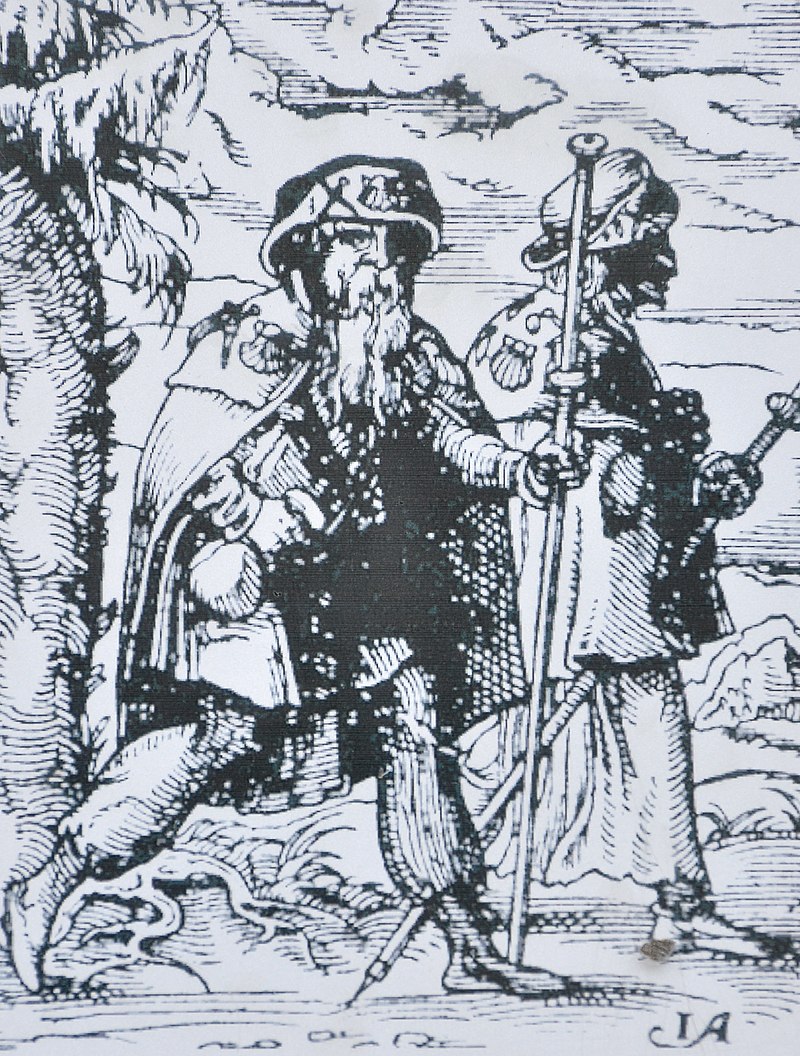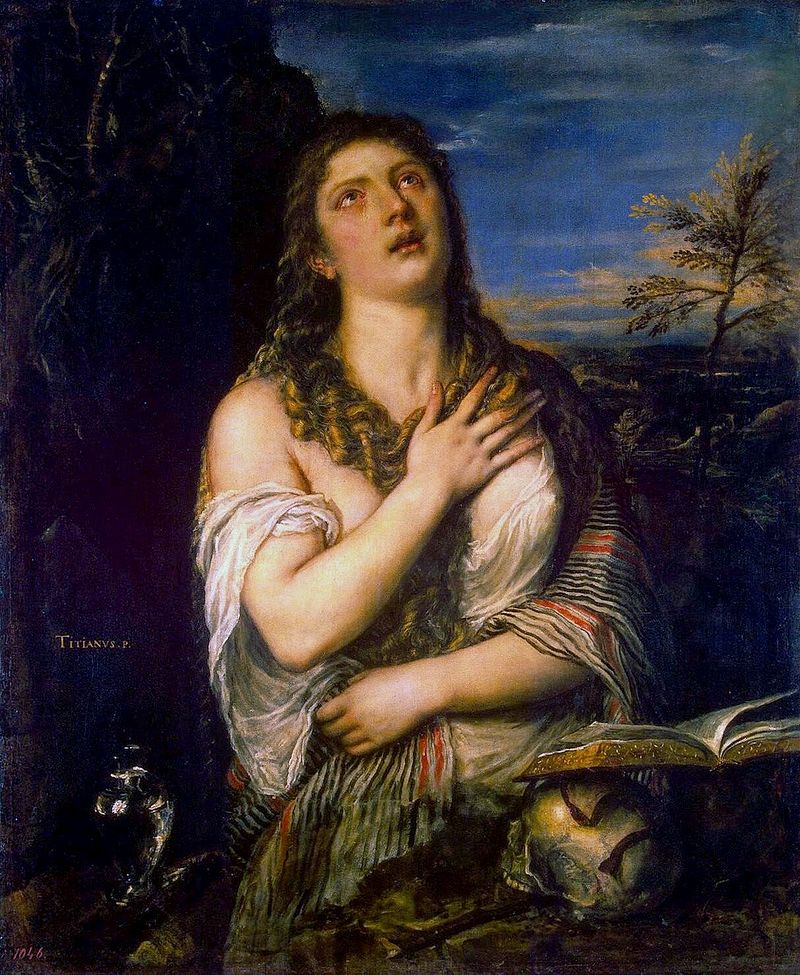
There are actually “Three Days of Halloween,” ending on November 2, with All Souls’ Day …
* * * *
 My last post was “Hola! Buen Camino!” It described some of my just-finished five-week trip to Spain (I was hiking – and biking – the Camino de Santiago.) I’ll be writing more about that trip later, but now it’s time to focus on the upcoming three days of Halloween. That set of three feast days is called the Halloween “Triduum,” or in the alternative Allhallowtide.
My last post was “Hola! Buen Camino!” It described some of my just-finished five-week trip to Spain (I was hiking – and biking – the Camino de Santiago.) I’ll be writing more about that trip later, but now it’s time to focus on the upcoming three days of Halloween. That set of three feast days is called the Halloween “Triduum,” or in the alternative Allhallowtide.
Triduum* is a fancy Latin word for “three days.” And the word “hallow” – in both “hallowe’en” and “Allhallowtide” – comes from the Old English word for “saint,” halig. That eventually became “hallow.” (Maybe it was easier to say.) Which led to November 1 now being called All Saints’ Day.
The Old English “All Haligs’ Day” – November 1 – eventually became “All Hallows Day.” The “eve” before that Feast Day – October 31 – became “All Hallows Evening.” In time that shortened to “All Hallows E’en.” Later still it shortened to “Hallowe’en,” then just plain Halloween.
There’s more on these three days of remembrance in “All Hallows E’en” – 2016, and earlier still in “All Hallows E’en” – 2015. But here’s the short and sweet version.
As Wikipedia noted, this three-day period is a “time to remember the dead, including martyrs, saints, and all faithful departed Christians.” The main day is November 1, now All Saints Day, but previously referred to as Hallowmas. It was established sometime between 731 and 741 – over 1,300 years ago – “perhaps by Pope Gregory III.”
 All Hallows’ Eve – October 31 – was originally established around that time as a vigil. That is, it was originally designed as a “period of purposeful sleeplessness, an occasion for devotional watching, or an observance.” (From the Latin word for “wakefulness.”) In other words, Halloween was originally designed to be more like the “Easter Vigil held at night between Holy Saturday and Easter Sunday.” That is, “a devotional exercise or ritual observance on the eve of a holy day:”
All Hallows’ Eve – October 31 – was originally established around that time as a vigil. That is, it was originally designed as a “period of purposeful sleeplessness, an occasion for devotional watching, or an observance.” (From the Latin word for “wakefulness.”) In other words, Halloween was originally designed to be more like the “Easter Vigil held at night between Holy Saturday and Easter Sunday.” That is, “a devotional exercise or ritual observance on the eve of a holy day:”
Such liturgical vigils usually consist of psalms, prayers and hymns, possibly a sermon or readings from the Holy Fathers, and sometimes periods of silent meditation.
But boy has that changed. (The painting above left shows “A Knight’s Vigil.” See the notes.)
There’s more on those changes below, but first note that November 1 honors “all the saints and martyrs, both known and unknown.” On the other hand, November 2 – All Souls’ Day – honors “all faithful Christians ‘who are unknown in the wider fellowship of the church, especially family members and friends.'” In other words, the rest of us poor schmucks…
But getting back to Halloween, a good friend recently asked how such a Holy Day “evolved into an opportunity to drink and party?” (Not to mention getting way too much candy…)
It all started with the old-time belief that evil spirits were most prevalent during the long nights of winter. Those “old-timers” also believed that the “barriers between our world and the spirit world” were at their its lowest and most permeable on the night of October 31:
So, those old-time people would wear masks or put on costumes in order to disguise their identities. The idea was to keep the afterlife “hallows” – ghosts or spirits – from recognizing the people in this, the “material world.”
 Another thing they did was build bonfires, or literally bonefires. (That is, “bonfires were originally fires in which bones were burned.”) The original idea was that evil spirits had to be driven away with noise and fire. But that evolved into this: The “fires were thought to bring comfort to the souls in purgatory and people prayed for them as they held burning straw up high.”
Another thing they did was build bonfires, or literally bonefires. (That is, “bonfires were originally fires in which bones were burned.”) The original idea was that evil spirits had to be driven away with noise and fire. But that evolved into this: The “fires were thought to bring comfort to the souls in purgatory and people prayed for them as they held burning straw up high.”
Like I said, there’s more information in “All Hallows E’en” – 2016, and in “All Hallows E’en” – 2015. (On things like trick-or-treating, jack-o’-lanterns representing “Christian souls in purgatory,” and “foolish fire” leading travelers from their safe paths “to their doom.”) But I’ll close with this:
There was another old-time custom, that if you had to travel on All Hallows E’en – like from 11:00 p.m. until midnight – your had to be careful. If your candle kept burning, that was a good omen. (The person holding the candle would be safe in the upcoming winter “season of darkness.”) But if your candle went out, “the omen was bad indeed.”
The thought was that the candle had been blown out by witches.
Have a Happy Halloween!
* * * *

* * * *
The upper image is courtesy of All Souls’ Day – Wikipedia, the free encyclopedia. The caption: “All Souls’ Day by William Bouguereau.” See also Allhallowtide, and All Saints’ Day – Wikipedia.
“Note” also that an asterisk in the main text indicates a statement supported by reference detailed in this “notes” section. Thus as to the term Triduum, it is usually defined as a “period of three days for prayer before a feast.” A better-known example is the Paschal Triduum, from Maundy Thursday through Easter Sunday.
Re: “A Knight’s Vigil.” That’s the title of the painting – by John Pettie (1839-1893) – to the left of the paragraph beginning “All Hallows’ Eve – October 31 – was originally…” The painting is courtesy of Vigil – Wikipedia, which added this note on knights’ vigils:
During the Middle Ages, a squire on the night before his knighting ceremony was expected to take a cleansing bath, fast, make confession, and then hold an all-night vigil of prayer in the chapel, preparing himself in this manner for life as a knight. For the knighting ceremony, he dressed in white as a symbol for purity and over that was placed a red robe to show his readiness to be wounded, over which a black robe was placed as a symbol of his willingness to die for his king.
The lower “witch” image is courtesy of Hail to Dorothy! The Wicked Witch is dead …54disneyreviews.
.jpg)
 Well, we did it. My brother and I arrived in
Well, we did it. My brother and I arrived in 
 Re: “Different kind of hell.” The allusion is to
Re: “Different kind of hell.” The allusion is to 
 In less than 24 hours I’ll be winging my way from Atlanta to
In less than 24 hours I’ll be winging my way from Atlanta to  And one of the best-known pilgrimages involves the
And one of the best-known pilgrimages involves the  That is,
That is,  In other words, exploring the mystical side of the Bible helps you “be all that you can be.” See
In other words, exploring the mystical side of the Bible helps you “be all that you can be.” See 
 And so our August 24 “St. Bart” is generally identified as the famous
And so our August 24 “St. Bart” is generally identified as the famous  But perhaps the best answer came from
But perhaps the best answer came from 
 Re: Pope John Paul II’s 1997 statement. He issued it on August 23, the eve of St. Bartholomew’s Day, in the city where the massacre took place. Note also the poignant painting by “
Re: Pope John Paul II’s 1997 statement. He issued it on August 23, the eve of St. Bartholomew’s Day, in the city where the massacre took place. Note also the poignant painting by “
 Last Sunday, August 6, was the
Last Sunday, August 6, was the  But then these Christians don’t build anything on top of that foundation. That results – spiritually speaking – in something like the image at right: A “foundation,” with noting built on top of it. Or put this way:
But then these Christians don’t build anything on top of that foundation. That results – spiritually speaking – in something like the image at right: A “foundation,” with noting built on top of it. Or put this way:

 On a more positive note, July 25 was the Feast Day for
On a more positive note, July 25 was the Feast Day for 
 I’ve used a lot of terms to describe that type of Christian; the kind this blog tries to challenge. To get them to “explore their full potential.” I’ve tried terms like
I’ve used a lot of terms to describe that type of Christian; the kind this blog tries to challenge. To get them to “explore their full potential.” I’ve tried terms like  Also, being too comfortable – in life or in Bible study – “causes negative mindset and attitude.” And that – unfortunately – is what many Christians are known for. (As noted in
Also, being too comfortable – in life or in Bible study – “causes negative mindset and attitude.” And that – unfortunately – is what many Christians are known for. (As noted in  The
The 

 Back in 2008, Republican presidential candidate
Back in 2008, Republican presidential candidate  At this point it should be noted that
At this point it should be noted that  Which is another way of saying the nastier you are, the more you “win.” It also means a person who is not content with being just a
Which is another way of saying the nastier you are, the more you “win.” It also means a person who is not content with being just a 
 “Note” also that an asterisk in the main text indicates a statement supported by a reference detailed further in this “notes” section. Thus as to
“Note” also that an asterisk in the main text indicates a statement supported by a reference detailed further in this “notes” section. Thus as to 
 I recently became
I recently became  Basically, his mother
Basically, his mother  So, just to keep things straight: Zilpah and Bilhah both bore two sons to Jacob. Rachel also bore two sons for Jacob. But the “winner” clearly was Leah, who gave Jacob six sons. (Or, to borrow a phrase from
So, just to keep things straight: Zilpah and Bilhah both bore two sons to Jacob. Rachel also bore two sons for Jacob. But the “winner” clearly was Leah, who gave Jacob six sons. (Or, to borrow a phrase from 
 An irreverent view of an
An irreverent view of an  The
The  Which makes this the perfect time to mention that June 15 is also the
Which makes this the perfect time to mention that June 15 is also the  Which is another way of saying that in reading the Bible, you don’t want to be one of those
Which is another way of saying that in reading the Bible, you don’t want to be one of those 